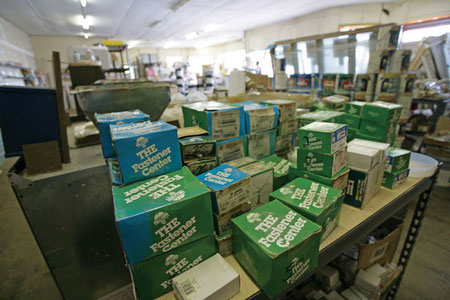Cheryl Ambrozic | Photography by Jason Moore
 Snaking between the stacked rows of paint cans, sidestepping around five-gallon drywall buckets filled with hurricane ties, straps and brackets, Kahului handyman Stan Bega scans the Habitat for Humanity ReStore with speed and excitement. “There’s a treasure,” he announces as he clutches an unused roll of double-sided construction tape. The price: 50¢. Tucking it under his arm next to the used glass-door rollers and new cabinet handles, he tells me, “This place is a gold mine.”
Snaking between the stacked rows of paint cans, sidestepping around five-gallon drywall buckets filled with hurricane ties, straps and brackets, Kahului handyman Stan Bega scans the Habitat for Humanity ReStore with speed and excitement. “There’s a treasure,” he announces as he clutches an unused roll of double-sided construction tape. The price: 50¢. Tucking it under his arm next to the used glass-door rollers and new cabinet handles, he tells me, “This place is a gold mine.”
Not an uncommon declaration overheard by workers at the Habitat for Humanity ReStore on Maui. On the Saturday morning I visited the ReStore, Bega calculated he saved $40. Returning every weekend, Bega and many other treasure hunters give truth to the cliché, “One man’s garbage is another man’s treasure.”
Located under the shadow of ‘Iao Valley in Happy Valley, Wailuku, the Habitat for Humanity ReStore is a recycling success story. The ReStore sells salvaged and surplus building materials donated by Maui’s building-supply retail stores, demolition crews, construction companies, and individual homeowners. From toilets and bathtubs to windows, hardware, and lumber, items that would have been dumped in Maui’s limited landfills are finding new owners and new homes.
“This is the Ross store for men,” laughs Habitat for Humanity Maui’s executive director Sherri Dodson as she describes the role reversal that takes place at this discount shop: wives wait outside while husbands peruse the bargains. Checking out the inventory, I quickly understand this place is full of good deals.
A self-proclaimed “Garage Sale Queen,” ReStore manager Karen Motooka is a savvy deal maker. Marking the unused donated items at 50 percent below the retail price and the used items 70 to 80 percent below retail, Motooka choreographs the bargaining dance to make a sale—a sale that is helping the entire island. Motooka tells me customers often give above the amount on her handwritten price tags, knowing the proceeds go to a good cause. They also know they are making out like bandits.
Dodson says the ReStore is based on the concept of “social enterprise.” Social enterprise allows nonprofits to have a for-profit arm that helps fund the nonprofit’s activities. This helps keep nonprofits viable, reducing the dependence on grant money or donations. While Habitat builders use donated items when possible, often the donations don’t match the specifications of the home, or the items would not fit with Habitat’s philosophy of “building simple and decent homes.” Dodson says Habitat avoids using high-end materials—a concept she calls “creeping affluence”—when building homes.
The income generated from the ReStore goes directly into Maui’s Habitat for Humanity building fund. Over the past two years on Maui, Habitat has built 11 homes and is now completing 5 more. The organization’s efforts have given 16 low-income Maui families the opportunity to break out of the cycle of poverty and into the American dream.
Although Habitat Maui is still in its infancy, development director Howie Kihune hopes as awareness and donations increase, hammers will soon swing with greater speed. Kihune says their goal is to build 20 homes a year on the Valley Isle. “We’re right on track with this goal,” he says. “We have committed to build 12 new homes in the first half of 2007.”
Since its grand opening in May 2005, the ReStore has not only been helping Maui’s struggling families, it’s also helping Maui’s environment.
Before the ReStore opened, these useable items became part of Maui’s burgeoning waste stream. On an island in the middle of the Pacific Ocean, with limited landfill space and a fast-growing population, this raises concern.
Maui’s operational landfills are quickly reaching their capacity. Maui has two main landfills: the public Central Maui landfill takes individual residents’ garbage, and the private Maui Demolition & Constriction (C&D) landfill takes commercial garbage.
Central Maui landfill supervisor Mike Souza welcomes any opportunity for abatement. Since he began working for Maui’s Solid Waste Division 26 years ago, Souza has watched the amount of garbage dumped into Maui’s landfills increase yearly. Solid-waste engineer Mike Kehano says, based on the current tons-per-day dumped into Phase 4A of the Central Maui landfill, it will fill up in one year. Kehano says phase 4B will open within a year, but with the increases in building, population, and tourism, he predicts 4B will be filled in four years.
According to Department of Health Solid Waste permitting engineer Gary Siu, the life expectancy of the current permitted area of the commercial C&D landfill is between five and six years. However, “That projected lifespan has not taken into consideration the recent construction boom. It will fill up faster with the current rate of hotel demolitions and resort remodels,” Siu says.
While the waste diversion made possible by the ReStore may not extend the life span of Maui’s landfills, it is providing a reduction in the current waste stream. “In the first six months that the ReStore was open, 3,226 pieces were diverted from the landfill,” explains Dodson. “In the first six months of 2006, we’ve doubled that. Many of the items resold were large items that take up a lot of room at the landfill, such as large windows and plumbing fixtures. In March 2006 alone, 2,819 pieces were diverted.” Dodson says that on average, about 3,000 pieces are diverted each month.
Income generated at the ReStore is limited only by the lack of retail space. Currently, the location is a meager 2,500 square feet. Habitat is planning to add 1,500 square feet but needs even more room to accept bulkier donations such as furniture, garage doors, and lumber. Kihune says they are looking for a centrally located property where they could build a 10,000-square-foot warehouse with room outside for parking.
Maui County Recycling coordinator Hana Steel is working to find County grant money to help Habitat build or rent a larger space. She couldn’t be happier with what the ReStore is accomplishing. Steel strives to make recycling a workable and economically viable process on Maui. “Increasing recycling efforts on Maui requires setting up systems that make it easy for people to redirect and reuse,” says Steel. “The ReStore is an important part of this recycling system. Just because one person is done with an item, as long as it still usable, it shouldn’t be entombed in a landfill.” Now open on Maui, Habitat for Humanity’s ReStore is resurrecting hopes for Maui’s struggling families and environment.




